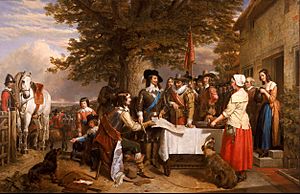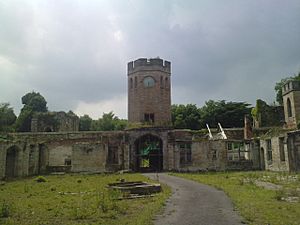Sir Thomas Liddell, 1st Baronet facts for kids
Sir Thomas Liddell, 1st Baronet (1578–1652) was an important English politician. He came from the Liddell family, who were very powerful in the North of England during the 1500s and 1600s. Sir Thomas was a strong supporter of the King's side, called the Royalists or Cavaliers, during the English Civil War.
Contents
About Sir Thomas Liddell's Family
Sir Thomas Liddell was born in 1578. His parents were Thomas Liddell (who died in 1619) and Margaret Watson. Margaret's father, John Watson, was an important city official in Newcastle.
Sir Thomas's grandfather, also named Thomas Liddell (who died in 1577), was a successful merchant. He held important roles in Newcastle, serving as Sheriff in 1563-64 and Mayor in 1572–73. Sir Thomas's father, Thomas (who died in 1619), was also a merchant. He made a lot of money from selling corn and coal. In 1607, he bought Ravensworth Castle. Like his father, he also served as Sheriff of Newcastle in 1592-93 and Mayor in 1597 and 1609.
Sir Thomas's Role in Politics and the Civil War

Sir Thomas Liddell was a Catholic, which meant he did not follow the official Church of England. When his father died in 1615, Sir Thomas inherited Ravensworth Castle. He also owned another large property called Redheugh in County Durham. In 1620, he joined Gray's Inn, which was a place where lawyers were trained.
Sir Thomas served as Sheriff of Newcastle in 1609. He was also elected Mayor of Newcastle several times: in 1625, 1634, and 1636. In April 1640, he was chosen to be a Member of Parliament for Newcastle-upon-Tyne. On November 2, 1642, King Charles I gave him the special title of baronet.
The English Civil War was a big fight between the King (Charles I) and Parliament. Sir Thomas Liddell was a strong supporter of the King's side, known as the Royalists or Cavaliers. He was a captain in the local army and joined the Royalist army in August 1642. He helped the King by secretly bringing weapons to the Royalist party. He also tried to stop people who supported Parliament from having power in Newcastle.
Sir Thomas fought in the Battle of Edgehill, a major battle in the war. He even provided horses for the King's soldiers. Later, he was part of the Royalist army defending Newcastle during the Siege of Newcastle by Parliament's forces. He wrote strong messages refusing to surrender to Parliament. However, the Royalist army in Newcastle was defeated in 1644. Sir Thomas was captured by Parliament's soldiers. In 1646, he was fined a large amount of money, £4,000, because he was seen as a major supporter of the King. He was released after agreeing to pay this fine. Sir Thomas died in 1652.
Sir Thomas Liddell's Children
In 1596, Sir Thomas Liddell married Isabel Anderson. They had 14 children together. Sadly, most of their children passed away before Sir Thomas did. His oldest son, also named Thomas, died before him. Because of this, Sir Thomas was succeeded by his grandson, Sir Thomas Liddell, 2nd Baronet. Interestingly, this grandson later became a Colonel for the Parliamentarian side in 1659 and married the daughter of a Parliamentarian leader, Sir Henry Vane the Younger.
Sir Francis Liddell (1607–1680)
Sir Francis Liddell was the second son of Sir Thomas Liddell. He was a Major in the King's army during the English Civil War, just like his father. King Charles I made Francis a knight in 1643. He was known as Sir Francis Liddell of Bamburgh Castle and Redheugh.
In 1636, Sir Francis spoke against John Blakiston, who later became famous for being involved in the King's execution. Sir Francis also served as Sheriff of Newcastle in 1640. After the Royalist side lost the war, Sir Francis, like his father, had to pay a fine in 1649.
After the King's power was brought back (this was called the Restoration of the monarchy), Sir Francis continued to be important. He served as Governor of the Hostmen (a group of coal merchants) in 1665 and was Mayor of Newcastle in 1666.
Sir Francis married Elizabeth Tonge first. They had 11 children. One of their sons was Francis Liddell (born 1633), who lived at Redheugh and later at Ogle Castle. After Elizabeth died, Sir Francis married Agnes Chaytor. Agnes had been married twice before. Sir Francis and Agnes also had children, including a son named Francis (born 1633) who married Agnes's daughter from her first marriage, Frances. They also had a daughter named Agnes Mary.


